10. The Duel Of The Fates – Star Wars: Episode I – The Phantom Menace

As you’d kinda expect given its name, the Star Wars saga is practically bursting at the seams with moments of monumental conflict. Indeed, numerous lightsaber duels, planetary skirmishes and interstellar dogfights could easily have made the cut for this list, but the three-way showdown between heroic Jedi Knights Qui-Gon Jinn and Obi-Wan Kenobi and the villainous Sith Lord Darth Maul in The Phantom Menace tops them all.
Set during the previously unseen heyday of the Jedi Order, this duel was the first time audiences glimpsed what combatants fuelled by the mystical Force were capable of – and boy, was it worth the wait! Actors Liam Neeson and Ewan McGregor – who played Qui-Gon and Obi-Wan, respectively – trained hard under swordmaster and stunt coordinator Nick Gillard to hone their swordplay skills to lightning-quick speed, allowing them to convincingly go toe-to-toe with martial artist Ray Park, who portrayed Maul.
Toss in some death-defying acrobatics, a drama-filled environment – there are no work place health and safety laws in a galaxy far, far away, apparently – and a pulse-pounding, choral-driven score by master composer John Williams, and you’re left with the greatest lightsaber dust-up of them all.
Admittedly, the so-called “Duel of the Fates” doesn’t quite have the sweeping, volcanic vistas and mythic baggage of the “Battle of the Heroes” at the end of Revenge of the Sith. Nor do we have quite the same emotional connection to our heroes as we do when watching Luke Skywalker face-off against Darth Vader in The Empire Strikes Back, or with Rey when she trades blows with Kylo Ren in The Force Awakens.
But these are minor quibbles: director George Lucas got plenty wrong with The Phantom Menace, but thanks to the hard work of Gillard, Neeson, McGregor and Park (not to mention countless other crew members), he really hit it out of the park with this sequence.
Best Moment: After Qui-Gon is mortally wounded by Maul, Obi-Wan rushes to defend his fallen master, and a blinding display of swordsmanship ensues.
9. Showdown at House of Blue Leaves – Kill Bill Vol.1
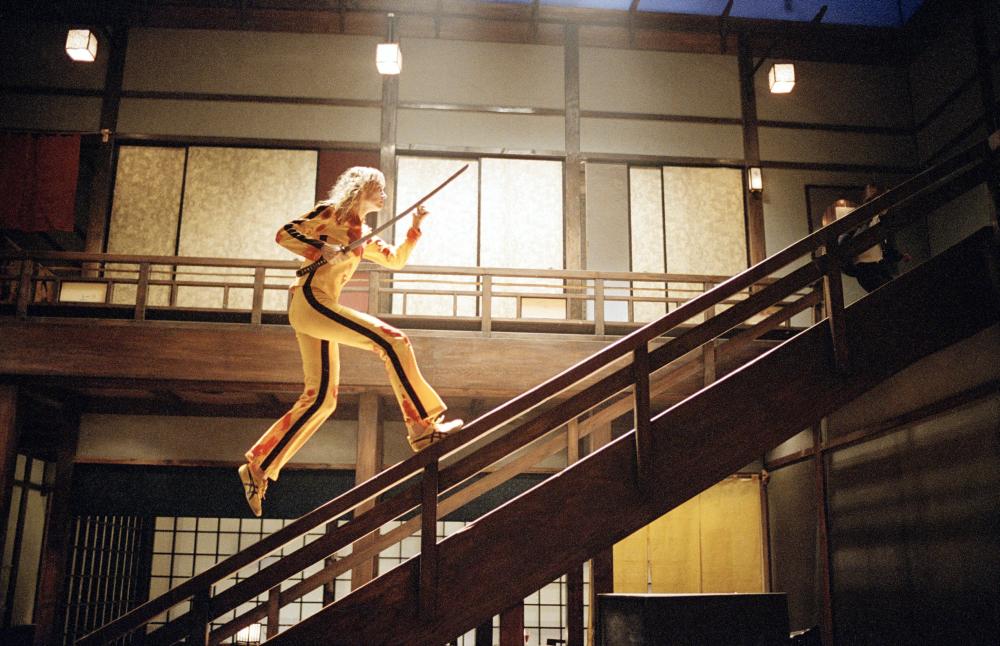
From the moment Reservoir Dogs arrived in cinemas, there was never any doubt that Quentin Tarantino knew what he was doing in the director’s chair. However, when the acclaimed auteur first announced two-part outing Kill Bill, the question on most peoples’ lips was: “Yeah, but can he shoot action?”
Well, as the Showdown at the House of Blue Leaves in Kill Bill Vol.1 more than proves, QT is as capable of coordinating a sustained, meticulously-choreographed action set piece as any blockbuster director. Here, Uma Thurman plays former assassin the Bride, who finds herself crossing samurai swords with Yakuza enforcers the Crazy 88, as well as sadistic, morning star-wielding school girl Gogo Yubari!
Through it all, Tarantino and fight choreographer Woo-Ping Yuen keep things interesting by varying the tempo – shifting gears from moments of fun high-speed, Hong Kong cinema-style carnage to instances of slow, nail-biting tension. Director of Photography Robert Richardson likewise keeps things visually dynamic, and the constant flitting between full colour and black & white footage is not only inspired, but ever slightly tones down some of the more intense instances of gore.
Best moment: Encircled by the Crazy 88, The Bride – a katana in each hand – dispatches her opponents in a gruesome yet balletic showcase of breakdancing-inspired combat, all to the feel good tune of “Nobody But Me” by the Human Beinz.
8. The Zero-Gravity Corridor Brawl – Inception
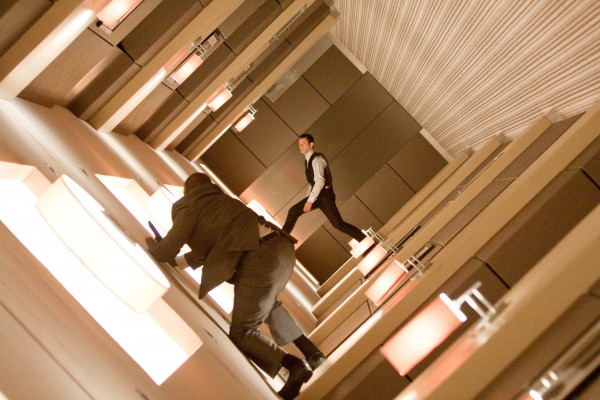
Think you need a cast of thousands, a surplus of pyrotechnics and an eye-melting amount of CGI to create a grandiose action scene? Well, the zero-gravity corridor brawl in Inception – which boasts only two participants, no explosions and very few digital effects – will make you rethink that assumption.
Shaking down in the same artificial reality as much of the rest of Christopher Nolan’s 2010 dream heist flick, this showstopping set-piece sees Joseph Gordon-Levitt’s Arthur tangle with a lone assailant in a scuffle that defies the laws of physics.
Special effects coordinator Chris Corbould, production designer Guy Hendrix Dyas and cinematographer Wally Pfister deserve all the kudos there is for realizing these fisticuffs predominantly through practical effects work.
Building the hotel corridor set on a special rig that could be rotated 360 degrees, the trio enabled Nolan to capture this mind-bending scrap in-camera – with CGI used mostly to remove safety wires from the performers – and that degree of verisimilitude is what makes this scene truly epic.
Best moment: Gravity in the dream world goes topsy-turvy, and the fighting shifts from the corridor carpet to its walls and finally to the ceiling!
7. The Bank Robbery – Heat
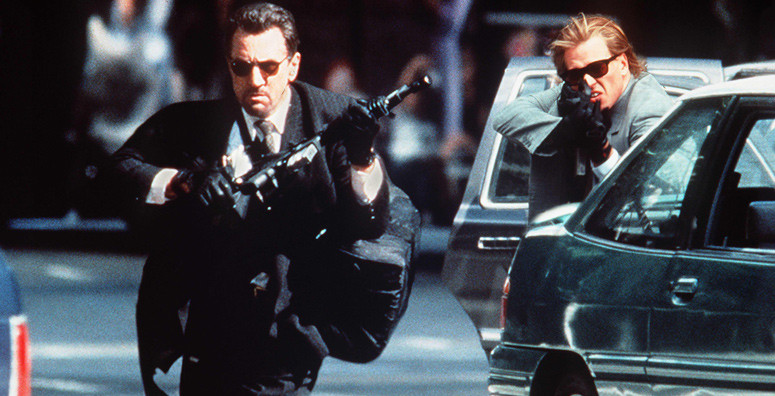
Michael Mann’s 1995 crime flick Heat is best known for finally uniting acting legends Al Pacino and Robert De Niro on screen – the pair both starred in The Godfather Part II, but shared no scenes together. So from that perspective, the most epic scene in the movie is arguably the “meeting of the minds” between Pacino’s cop Vincent Hanna and De Niro’s crook Neil McCauley in a diner halfway through proceedings.
But that would be doing Heat’s bank robbery set-piece a huge disservice, which, in its own way, is just as riveting as the earlier exchange between Hanna and McCauley. Here, Mann expertly ratchets up the tension to near-unbearable levels, and cinematographer Dante Spinotti’s sleek visuals are elegant without sacrificing the gritty, grounded reality of the narrative.
But the beauty of the scene truly lies in the way that McCauley is as much a lead character as Hanna – so that we’re kinda rooting for both men to succeed. This leaves us racked with anxiety over the fates of both men, especially once the gunfire breaks out and it becomes abundantly clear that not everyone is going to make it out alive…
Biggest moment: Their getaway car (and driver) out of action, McCauley and his crew find themselves caught in a firefight with an implacable police cordon.
6. The Battle For New York City – The Avengers
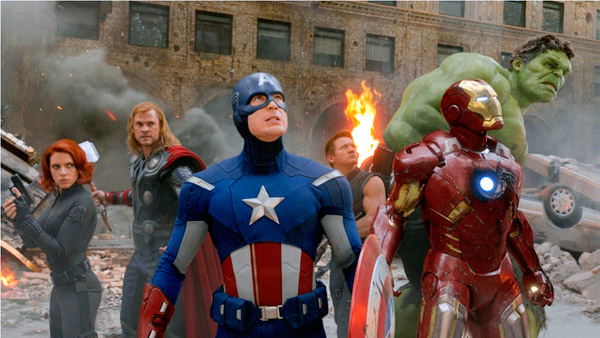
It seems unthinkable now, but prior to the release of The Avengers, nobody was sure that director Joss Whedon would stick the landing on Marvel Studio’s team-up joint – creatively or commercially.
Not only did Whedon manage to keep all the plates spinning (frustratingly vague supervillain plot notwithstanding), but he did so with gusto, delivering a critical and financial smash-hit that set the stage for Marvel’s unprecedented popularity going forward.
In the years since Avengers hit cinemas, Marvel has managed to squeeze far more heroes into a single film – and arguably to even greater effect. But it’s hard to top the impact of seeing Earth’s Mightiest Heroes join forces together on screen for the first time, defending New York City from an alien invasion force in suitably high-stakes fashion.
What’s more, Whedon cleverly peppers the wider destruction with mini-vignettes where our heroes combine their amazing powers in spectacular fashion – ensuring that every hero (and the A-Listers playing them) gets his or her moment to shine, and providing a template for the filmmakers who followed in his footsteps.
Biggest moment: The camera does a full, 360 pan around the entire team – Captain America, Iron Man, Thor, Black Widow, Hawkeye and Hulk – creating instantly iconic imagery in the process.
5. The Home Straight – Mad Max: Fury Road
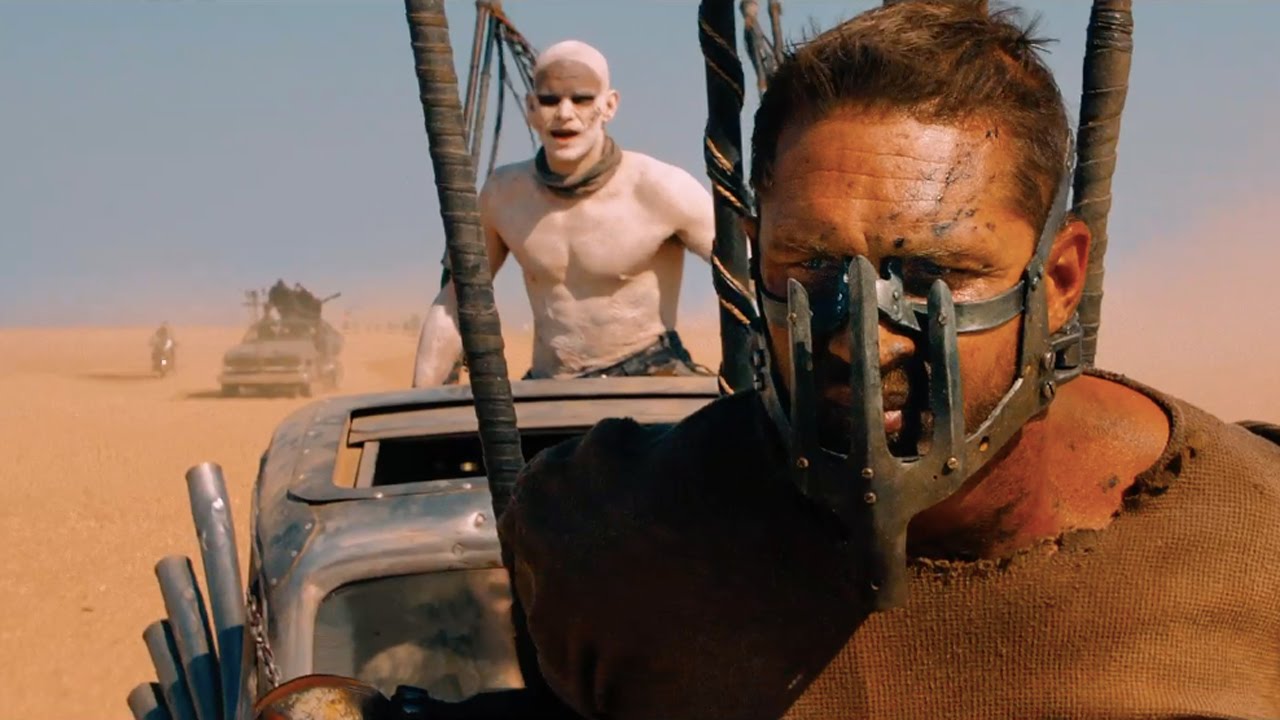
Mad Max: Fury Road features so much vehicular mayhem – and functions as virtually one long, barely-interrupted chase – that it would be easy to just count the entire flick as a single, epic scene.
That said, the final sprint down the “home straight” made by Tom Hardy’s Max, Charlize Theron’s Furiosa and their allies just manages to trump everything that came before it.
With franchise creator George Miller once more at the helm on Fury Road, the climatic race back to evil overlord Immortan Joe’s Citadel stronghold is an unsurprisingly white-knuckle affair. By this point, we’ve come to care for Max, Furiosa and the exploited women under their protection – giving us an actual reason to care when they’re imperilled by Joe and his hot-rod riding thugs.
What’s more, it all looks gorgeous thanks to cinematographer John Seale’s vivid palette, and Miller’s insistence on using fully-functional big rig trucks and over 150 flesh-and-blood stuntmen provides a level of excitement an all CGI-finale would struggle to muster.
Biggest moment: Furiosa rips Immortan Joe’s grotesque breathing apparatus from his face; a grizzly fate – but it couldn’t have happened to a nicer guy!
4. The Maelstrom Battle – Pirates of the Caribbean: At World’s End

Say what you will about Pirates of the Carribbean: At World’s End, but the finale of Gore Verbinski’s film is an unqualified doozy. Verbinski and screenwriters Ted Elliott and Terry Russio stage the climatic naval battle in the midst of a swirling vortex, whilst our heroes and villains engage in the kind of unfettered swashbuckling action Errol Flynn could only dream about.
As you’d expect, Johnny Depp’s drunken sailor Jack Sparrow is in the thick of the action. At one point, Sparrow even finds himself duelling (sea)monster man Davy Jones (brought to life by Bill Nighy and the digital wizards at ILM) atop the rigging of a ship’s mast, as Director of Photography Dariusz Wolski’s camera pans dramatically around them.
That’s not to say that Sparrow has all the fun, though. Will Turner (Orlando Bloom) and Elizabeth Swann (Keira Knightly) more than hold their own in the extensive close-quarters fighting that takes place – even finding time to be married by Geoffrey Rush’s cackling pirate Captain Barbossa!
Biggest moment: Tom Hollander’s once-smarmy villain Cutler Beckett descends the stairs of the Endeavour in a defeated stupor, oblivious to the ship being blown to smithereens around him.
3. The Lobby Shoot-Out – The Matrix
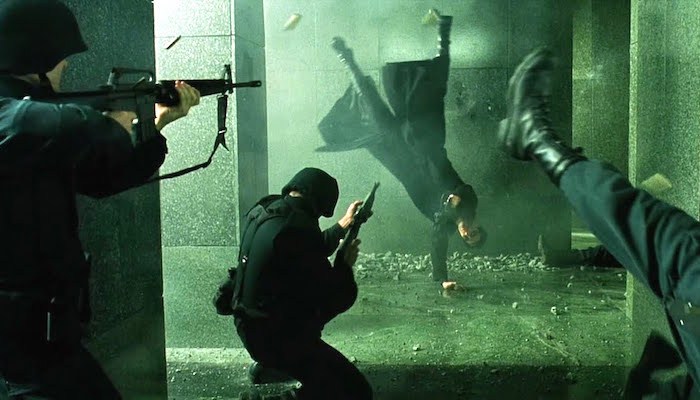
By the standards of the subsequent entries in The Matrix trilogy, the scope of the lobby shoot-out in the first film is relatively modest. Yet this practical effects-heavy, CGI-lite affair is more convincing, better paced and packs in more tension than anything else the Wachowskis cooked up later on.
Keanu Reeves (him again!) stars as digital messiah Neo, who – together with Carrie-Anne Moss’ kick-butt love interest Trinity – storms the virtual reality headquarters of villainous computer security bots, the Agents, to rescue his captive mentor, Morpheus.
Despite being vastly outnumbered, Neo and Trinity’s ability to pull off superhuman feats of speed, strength and agility – not to mention their crazy-good martial arts skills and frankly absurd arsenal of weaponry – soon evens the odds.
Fight coordinator Yuen Woo-Ping choreographs proceedings like a live-action anime, and Director of Photography Bill Pope frames every beat of the hyper-stylized action perfectly. It took 10 days to film – and God knows how many explosive squibs – but it was worth it: the lobby scene isn’t just biggest action scene in The Matrix, it’s still the best set-piece the Wachowskis have ever committed to film.
Best moment: The obvious choice would be any of the acrobatic takedowns Neo and Trinity visit on their attackers – but that overlooks the understated comedy of the closing shot of the scene, where the apple core-like concrete columns underscore the scale of what just went down.
2. The Battle Of Pelennor Fields – The Lord of the Rings: The Return of the King

Some would argue that the Battle of Helm’s Deep seen in The Two Towers deserves this slot. But as jaw-droppingly epic as that climatic clash is, it looks like a minor quarrel compared to the sheer scale of the Battle of Pelennor Fields that forms the centrepiece of The Return of the King.
It doesn’t hurt that the fighting here comes hot on the heels of the protracted siege of nearby Minas Tirith by the unwashed Orc hordes loyal to baddie Sauron, the two scenes effectively combining to make one of the longest (and most incredible) action set-pieces of all time.
It’s to director Peter Jackson’s credit that he’s able to keep such a prolonged period of fighting interesting, and the cast – particularly Bernard Hill as King Theoden, and Miranda Otto as Eowyn – outdo themselves when it comes to anchoring the potentially soulless spectacle with true human emotion.
Sure, some of the pioneering visual effects work by WETA Digital hasn’t aged well – most notably, some of the crowd simulations using the groundbreaking MASSIVE software don’t quite hold up – in the 15 years since Return of the King was first released. Yet there’s so much to love here, from the inspirational charge of the Riders of Rohan, to the devastation wrought by giant elephants the Mumakil, through to the last minute arrival of the Army of the Dead, you’ll barely notice the rough edges.
Best moment: With the orcs routed, Theoden and company breathe a sigh of relief – only to hear the approaching, thunderous footsteps of the Mumakil; it’s a clever, subtle build-up to a second, spectacularly less triumphant cavalry charge…
1. D-Day – Saving Private Ryan
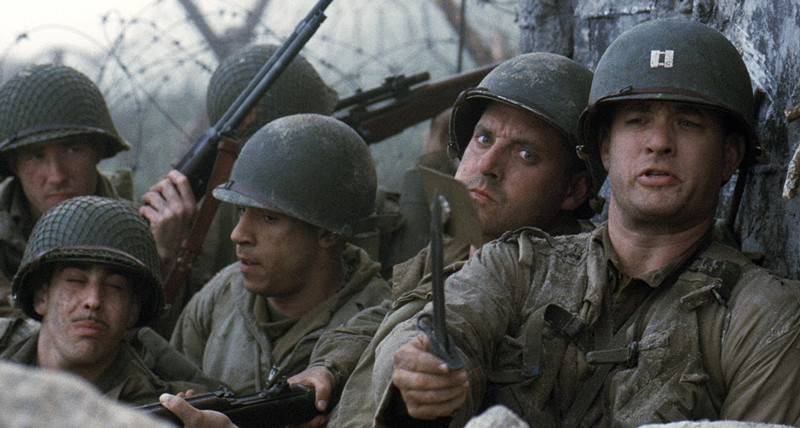
Steven Spielberg’s Saving Private Ryan is a strong contender for the greatest war movie ever made, with the opening D-Day battle on Omaha Beach arguably the first time audiences had witnessed the true horrors of war on the big screen.
It’s a harrowing scene – depicting the senseless carnage and chaos of a pitched firefight with an almost newsreel-level of intensity – that is nonetheless impressively epic. But what really stands out amidst the gritty, mud-drenched realism is how well Spielberg captures the inherent heroism of the soldiers stationed on the front lines in World War II.
Tom Hanks is perfectly cast as everyman Captain Miller, who steadfastly guides his troops through the fog of war with an understated courage that resonates all the same. This – along with the closing shots of countless dead bodies washing ashore on crimson waves – ensures that the director is able to instil his recreation of D-Day with a much-needed emotional undercurrent, as well.
Best moment: The doors of the troop transports come down, and all Hell breaks loose before a single boot touches down on the sands of the beach.